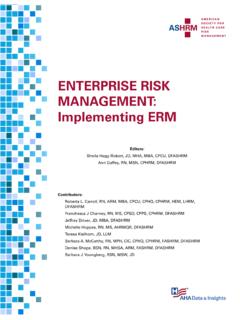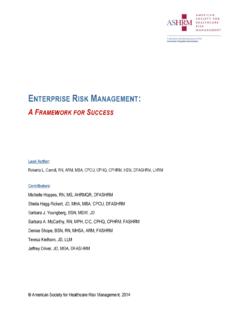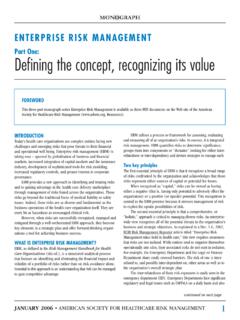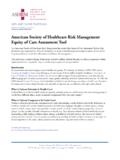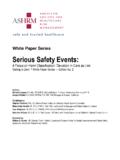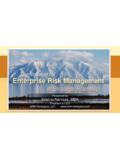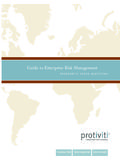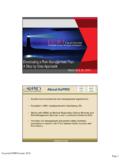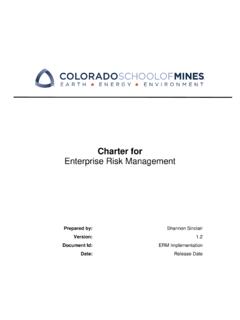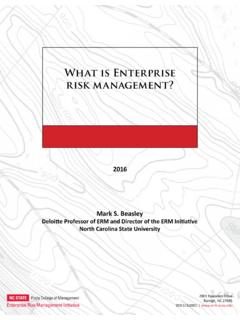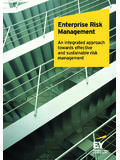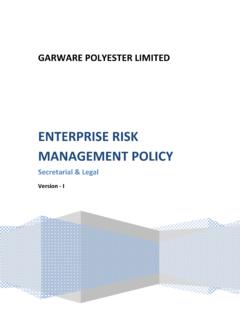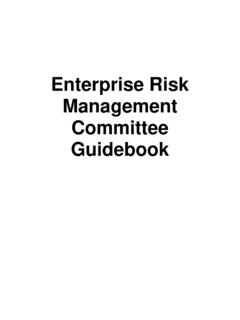Transcription of NTERPRISE RISK MANAGEMENT
1 American Society for Healthcare Risk MANAGEMENT , 2014 enterprise RISK MANAGEMENT : A FRAMEWORK FOR SUCCESS Lead Author: Roberta L. Carroll, RN, ARM, MBA, CPCU, CPHQ, CPHRM, HEM, DFASHRM, LHRM Contributors: Michelle Hoppes, RN, MS, AHRMQR, DFASHRM Sheila Hagg-Rickert, JD, MHA, MBA, CPCU, DFASHRM Barbara J. Youngberg, BSN, MSW, JD Barbara A. McCarthy, RN, MPH, CIC, CPHQ, CPHRM, FASHRM Denise Shope, BSN, RN, MHSA, ARM, FASHRM Teresa Kielhorn, JD, LLM Jeffrey Driver, JD, MBA, DFASHRM enterprise Risk MANAGEMENT : A Framework for Success ASHRM 2014 2 | P a g e Table of Contents Page 3 FRAMEWORK .. 3 GUIDING PRINCIPLES .. 4 GOVERNANCE .. 5 ERM 8 RISK & OPPORTUNITY IDENTIFICATION .. 8 RISK EVALUATION & ASSESSMENT .. 11 STRATEGIC RISK RESPONSE .. 16 REVIEW / EVALUATE / MONTIOR .. 18 CONCLUSION .. 19 END NOTES .. 20 enterprise Risk MANAGEMENT : A Framework for Success ASHRM 2014 3 | P a g e Abstract: Healthcare organizations have made significant strides in developing enterprise Risk MANAGEMENT (ERM) programs, but there is still much work to be done.
2 To facilitate this process, ASHRM has defined ERM and created an ERM Framework for use in healthcare around which an ERM Program can be formed. This white paper will graphically display the Framework and describe key structural components necessary in any healthcare setting. Use this Framework to help build consistency in your efforts to move ERM forward. Audience: Novice, intermediate risk professional, or anyone desiring more information on ERM Keywords: enterprise Risk MANAGEMENT , ERM, Framework, Guiding Principles, Governance, Risk & Opportunity Identification, Assessment, Risk Response, Risk Evaluation INTRODUCTION The advancement of healthcare enterprise Risk MANAGEMENT is a key initiative in ASHRM s Strategic plan for 2014-2015. The implementation and maturity of ERM programs in healthcare organizations while making significant strides still lag behind large organizations, public companies, and financial services organizations.
3 Although many healthcare risk- MANAGEMENT professionals implement ERM strategies for new programs, projects and services (particularly to manage clinical, and patient-safety related risks ), they fail to advance ERM strategies on an organization-wide basis beyond those risks and thus miss tremendous opportunity to increase or create value. Recognizing the elements necessary for ERM program development and implementation and embedding them in the enterprise is central to program success and sustainability. Supporting this key ASHRM initiative is the development of a framework around which an ERM Program can be structured along with a clear, concise and easily understood definition of ERM. This paper offers guidance on ERM methods specific to healthcare organizations. It outlines ASHRM s ERM Framework highlighting structural components to support a solid foundation, promote program credibility and success, and advance ERM principles throughout your healthcare organization.
4 FRAMEWORK The Framework, as illustrated in this paper (See Graphic #1) ASHRMs ERM Framework, depicts a sample structure that can be utilized by any risk- MANAGEMENT professional as the developmental foundation of an organization-wide ERM program. Understandably, each organization s ERM program will vary due to differences in mission, vision, culture and strategic direction. However, components shown in the sample Framework are relevant to any healthcare organization. Each group may adopt these elements in a manner that accommodates the differences noted. Flexibility is important as a one-size-fits-all approach is not applicable in ERM. Realizing this at the outset will encourage the risk MANAGEMENT professional to define and modify basic structural elements in the Framework to fit their specific organizational needs, particularly as they relate to unique delivery settings.
5 This sample Framework allows for vital flexibility to create a unique and individualized healthcare ERM program. Once a Framework to address the specific needs of the organization is developed, the process may begin for creating program success building blocks such as: informing, consulting, learning, communicating and reporting. enterprise Risk MANAGEMENT : A Framework for Success ASHRM 2014 4 | P a g e GUIDING PRINCIPLES The following Guiding Principles in concert with ASHRM s mission and vision have been developed as basic building blocks supporting the Framework for ERM in healthcare: Advance safe and trusted healthcare Manage uncertainty Maximize value protection and creation Encourage multidisciplinary accountability1 Optimize organizational readiness Promote positive organizational culture which will impact readiness and success Advance ERM Practices ERM programs once started are continuous2 and are a paradigm shift in how an organization identifies and manages risks and opportunities.
6 These comprehensive programs are not a stop on the road, but a journey. 3 Utilize data/metrics to prioritize risks Align risk appetite and strategy GRAPHIC #1 ASHRM S ERM FRAMEWORK enterprise Risk MANAGEMENT : A Framework for Success ASHRM 2014 5 | P a g e GOVERNANCE The Governing Body4 of each healthcare organization is ultimately responsible for its ERM program. It is accountable either directly or through the leadership team for: Defining ERM as appropriate for the organization Creating and maintaining a culture that is supportive of ERM Determining strategy and program objectives Establishing parameters and levels for risk appetite and tolerance statements Establishing the ERM structure Approving the ERM plan (as well as communication and reporting plans) Providing ERM program oversight Each of these areas is described in more detail below. Definition of ERM Adopting a definition of ERM that is clear, concise and understandable is one of the significant early steps in developing an ERM Program.
7 Without an articulated definition the organization can embrace, the activities associated with ERM development and implementation can become disjointed and without purpose. ASHRM has adopted the following definition. enterprise risk MANAGEMENT in healthcare promotes a comprehensive framework for making risk MANAGEMENT decisions which maximize value protection and creation by managing risk and uncertainty and their connections to total value. 5 Other credible organizations such as the Committee of Sponsoring Organizations of the Treadway Commission6 (COSO), The American Heath Lawyers Association7 (AHLA), the Risk and Insurance MANAGEMENT Society (RIMS)8, and the International Organization of Standardization ISO 31000:20099 have all defined ERM, albeit differently. See the Endnotes for those definitions. TABLE #1 Terms & Complimentary Descriptions Comprehensive Framework Value Protection Value Creation Managing Uncertainty Organizational-wide Holistic Broad perspective Synergistic effect Comprehensive Strategic Thorough Robust Structured Reduce uncertainty Reduce variability Duplication Separation Shield asset Efficient use of resources Quality outcomes Safe practices Increased market share Competitive edge Financial strength Improved ROI Increased margins Enhanced reputation Improved satisfaction scores Quality Outcomes Credible Respected Reduce risks Eliminate Loss Promote standardization Use Evidence-Based Practice Decrease Variability View the impact of risk holistically not in silos (eliminate silo mentality)
8 Understand Chaos theory Eliminate/minimize lost opportunities Captures the positive or upside enterprise Risk MANAGEMENT : A Framework for Success ASHRM 2014 6 | P a g e Culture A Guiding Principle and key element in program implementation is culture and organizational readiness. The Governing Body is responsible for setting the stage to ensure the organization s culture will support the ERM program. Organizations that adopt fear as a practice, engage in tactics that are not conducive to a learning environment, are not fair and just in dealing with employees and staff, allow for disruptive behavior, and use risk reporting as the basis for disciplinary action are not ready for ERM and will fail if they try to implement a program. Anecdotally, a supportive, positive culture correlates (positively) to quality outcomes, performance and employee satisfaction.
9 However, no culture assessment instrument measured all three dimensions Nevertheless, there are many strategic initiatives that support a culture conducive to ERM, including programs such as: Organizing for High Reliability (HRO), Crew Resource MANAGEMENT (CRM), TEAMSTEPPS , Just Culture, concepts of Mindfulness, and support for critical thinking. Many use the term culture in concert with organizational climate and environment even given subtle, but distinct differences. Strategy A defined strategy is MANAGEMENT s game plan for strengthening enterprise performance. It is the long-term action plan designed to achieve a particular goal or set of goals or In years past, an organization s Board of Directors, in concert with senior leadership, drafted a 5 - 10 year strategic plan . Not the case in 2014! With today s complex and rapid shifts in healthcare, organizations develop strategic plans to cover six months to two years.
10 They rely on committees; engage additional staff, and review and modify the strategic plan as frequently as each quarter. Organizational strategy is directly linked to an organization s vision, mission, goals and objectives. (See Graphic #2: Steps to Create a Strategic plan ). Steps to Create a Strategic PlanVisionMissionGoals & ObjectivesStrategyTacticsRPIs / KRIsGRAPHIC #2 STRATEGIC plan enterprise Risk MANAGEMENT : A Framework for Success ASHRM 2014 7 | P a g e Objectives Objective setting is an important step in ensuring the ERM strategy and comprehensive ERM plan are actionable and operationalized. Clear objectives offer a roadmap that will support goal attainment. Several tools can assist in the development of objectives, including: a S W O T analysis to determine organizational Strengths, Weaknesses, Opportunities and Threats and developing S M A R T12 goals.
